 W
WMagnetism is a class of physical phenomena that are mediated by magnetic fields. Electric currents and the magnetic moments of elementary particles give rise to a magnetic field, which acts on other currents and magnetic moments. Magnetism is one aspect of the combined phenomenon of electromagnetism. The most familiar effects occur in ferromagnetic materials, which are strongly attracted by magnetic fields and can be magnetized to become permanent magnets, producing magnetic fields themselves. Demagnetizing a magnet is also possible. Only a few substances are ferromagnetic; the most common ones are iron, cobalt and nickel and their alloys. The prefix ferro- refers to iron, because permanent magnetism was first observed in lodestone, a form of natural iron ore called magnetite, Fe3O4.
 W
WArs Magnesia was a book on magnetism by the Jesuit scholar Athanasius Kircher in 1631. It was his first published work, written while he was professor of ethics and mathematics, Hebrew and Syriac at the University of Würzburg. It was published in Würzburg by Elias Michael Zink.
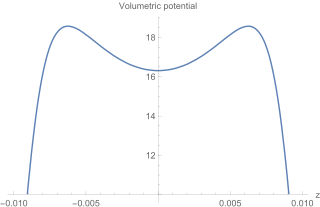 W
WA camelback potential is potential energy curve that looks like a normal distribution with a distinct dip where the peak would be, so named because it resembles the humps on a camel's back. The term was applied to a configuration of a superconducting quantum interference device in 2009, and to an arrangement of magnets in 2014.
 W
WCrustal magnetism is the magnetic field of the crust of a planetary body. The crustal magnetism of Earth has been studied; in particular, various magnetic crustal anomalies have been studied. Two examples of crustal magnetic anomalies on Earth that have been studied in the Americas are the Brunswick magnetic anomaly (BMA) and East Coast magnetic anomaly (ECMA). Also, there can be a correlation between physical geological features and certain readings from crustal magnetism on Earth. Below the surface of the Earth, the crustal magnetism is lost because the temperature rises above the curie temperature of the materials producing the field.
 W
WDiamagnetic materials are repelled by a magnetic field; an applied magnetic field creates an induced magnetic field in them in the opposite direction, causing a repulsive force. In contrast, paramagnetic and ferromagnetic materials are attracted by a magnetic field. Diamagnetism is a quantum mechanical effect that occurs in all materials; when it is the only contribution to the magnetism, the material is called diamagnetic. In paramagnetic and ferromagnetic substances, the weak diamagnetic force is overcome by the attractive force of magnetic dipoles in the material. The magnetic permeability of diamagnetic materials is less than the permeability of vacuum, μ0. In most materials, diamagnetism is a weak effect which can only be detected by sensitive laboratory instruments, but a superconductor acts as a strong diamagnet because it repels a magnetic field entirely from its interior.
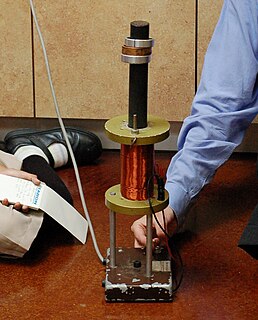 W
WElectrodynamic suspension (EDS) is a form of magnetic levitation in which there are conductors which are exposed to time-varying magnetic fields. This induces eddy currents in the conductors that creates a repulsive magnetic field which holds the two objects apart.
 W
WElectron paramagnetic resonance (EPR) or electron spin resonance (ESR) spectroscopy is a method for studying materials with unpaired electrons. The basic concepts of EPR are analogous to those of nuclear magnetic resonance (NMR), but it is electron spins that are excited instead of the spins of atomic nuclei. EPR spectroscopy is particularly useful for studying metal complexes or organic radicals. EPR was first observed in Kazan State University by Soviet physicist Yevgeny Zavoisky in 1944, and was developed independently at the same time by Brebis Bleaney at the University of Oxford.
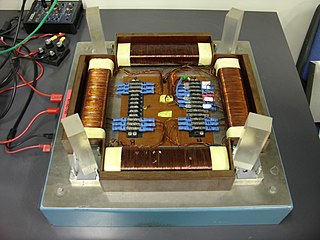 W
WAn Epstein frame or Epstein square is a standardised measurement device for measuring the magnetic properties of soft magnetic materials, especially used for testing of electrical steels.
 W
WAn electric generator or electric motor consists of a rotor spinning in a magnetic field. The magnetic field may be produced by permanent magnets or by field coils. In the case of a machine with field coils, a current must flow in the coils to generate the field, otherwise no power is transferred to or from the rotor. The process of generating a magnetic field by means of an electric current is called excitation. Field coils yield the most flexible form of magnetic flux regulation and de-regulation, but at the expense of a flow of electric current. Hybrid topologies exist, which incorporate both permanent magnets and field coils in the same configuration. The flexible excitation of a rotating electrical machine is employed by either brushless excitation techniques or by the injection of current by carbon brushes.
 W
WThe Fermi contact interaction is the magnetic interaction between an electron and an atomic nucleus. Its major manifestation is in electron paramagnetic resonance and nuclear magnetic resonance spectroscopies, where it is responsible for the appearance of isotropic hyperfine coupling.
 W
WFerrofluid is a liquid that is attracted to the poles of a magnet.
 W
WIn physics, Gauss's law for magnetism is one of the four Maxwell's equations that underlie classical electrodynamics. It states that the magnetic field B has divergence equal to zero, in other words, that it is a solenoidal vector field. It is equivalent to the statement that magnetic monopoles do not exist. Rather than "magnetic charges", the basic entity for magnetism is the magnetic dipole.
 W
WHammerscale, also written hammer scale, is a flaky or spheroidal byproduct of the iron forging process. Hammerscale is almost universally recovered from archaeological excavations in areas where iron ore was refined and forged. Hammerscale’s magnetic character also aids in its recovery and in mapping larger features by means of magnetic susceptibility surveys. Hammerscale can provide vital information about an archeological site such as the function of the feature.
 W
WHanna curve - a curve defining magnetic parameters of an inductor.
 W
WThe history of electromagnetic theory begins with ancient measures to understand atmospheric electricity, in particular lightning. People then had little understanding of electricity, and were unable to explain the phenomena. Scientific understanding into the nature of electricity grew throughout the eighteenth and nineteenth centuries through the work of researchers such as Coulomb, Ampère, Faraday and Maxwell.
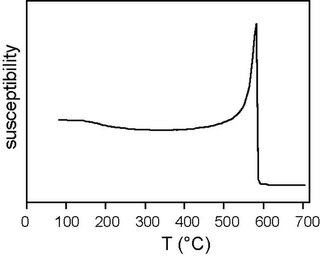 W
WThe Hopkinson effect is a feature of ferromagnetic or ferrimagnetic materials, in which an increase in magnetic susceptibility is observed at temperatures between the blocking temperature and the Curie temperature of the material. The Hopkinson effect can be observed as a peak in thermomagnetic curves that immediately precedes the susceptibility drop associated with the Curie temperature. It was first observed by John Hopkinson in 1889 in a study on iron.
 W
WA horseshoe magnet is a magnet made in the shape of a horseshoe. At the ends of its legs, the magnet has two magnetic poles close together. This shape creates a strong magnetic field between the poles.
 W
WHuman magnetism is a popular name for an alleged ability of some people to attract objects to their skin. People alleged to have such an ability are often called human magnets. Although metal objects are the most popular, some are also alleged to be able to stick other types of materials, such as glass, porcelain, wood or plastic as well as metals with no ferromagnetic properties such as brass and aluminium. However, none of the recorded claims of human magnetism corresponds with the physics of magnetism, indicating that this "ability" is in fact nothing more than a misunderstanding of the physics and meaning of the term and a misapplication of it to what has been shown to be nothing more than unusually sticky skin.
 W
WMagnes sive de Arte Magnetica is a 1641 work by the Jesuit scholar Athanasius Kircher. It was dedicated to Emperor Frederick III and printed in Rome by Hermann Scheuss. It developed the ideas set out in his earlier Ars Magnesia and argued that the universe is governed by universal physical forces of attraction and repulsion. These were, as described in the motto in the book's first illustration, 'hidden nodes' of connection. The force that drew things together in the physical world was, he argued, the same force that drew people's souls towards God. The work is divided into three books: 1.De natura et facultatibus magnetis, 2.Magnes applicatus, 3.Mundus sive catena magnetica. It is noted for the first use of the term 'electromagnetism'.
 W
WMagnes the shepherd, sometimes described as Magnes the shepherd boy, is a mythological figure, possibly based on a real person, who was cited by Pliny the Elder as discovering natural magnetism. His name, "Magnes", the Latin word for magnetite, has been attributed as the origin of the Latin root that has passed into English, giving its speakers the words magnet, magnetism, the mentioned ore, and related formulations. Other authorities have attributed the word origin to other sources.
 W
WA magnet is a material or object that produces a magnetic field. This magnetic field is invisible but is responsible for the most notable property of a magnet: a force that pulls on other ferromagnetic materials, such as iron, and attracts or repels other magnets.
 W
WMagnet fishing, also called magnetic fishing, is searching in outdoor waters for ferromagnetic objects available to pull with a strong neodymium magnet.
 W
WA magnet keeper, also known historically as an armature, is a bar made from magnetically soft iron or steel, which is placed across the poles of a permanent magnet to help preserve the strength of the magnet by completing the magnetic circuit; it is important for magnets that have low magnetic coercivity, such as alnico magnets (0.07T).
 W
WThe gyrator–capacitor model - sometimes also the capacitor-permeance model - is a lumped-element model for magnetic circuits, that can be used in place of the more common resistance–reluctance model. The model makes permeance elements analogous to electrical capacitance rather than electrical resistance. Windings are represented as gyrators, interfacing between the electrical circuit and the magnetic model.
 W
WA magnetic dipole is the limit of either a closed loop of electric current or a pair of poles as the size of the source is reduced to zero while keeping the magnetic moment constant. It is a magnetic analogue of the electric dipole, but the analogy is not perfect. In particular, a magnetic monopole, the magnetic analogue of an electric charge, has never been observed. Moreover, one form of magnetic dipole moment is associated with a fundamental quantum property—the spin of elementary particles.
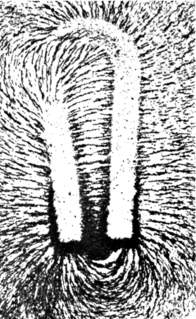 W
WA magnetic field is a vector field that describes the magnetic influence on moving electric charges, electric currents, and magnetized materials. A charge that is moving in a magnetic field experiences a force perpendicular to its own velocity and to the magnetic field. The effects of magnetic fields are commonly seen in permanent magnets, which pull on magnetic materials such as iron, and attract or repel other magnets. In addition, a magnetic field that varies with location will exert a force on a range of non-magnetic materials by affecting the motion of their outer atomic electrons. Magnetic fields surround magnetized materials, and are created by electric currents such as those used in electromagnets, and by electric fields varying in time. Since both strength and direction of a magnetic field may vary with location, they are described as a map assigning a vector to each point of space or, more precisely—because of the way the magnetic field transforms under mirror reflection—as a field of pseudovectors.
 W
WIn physics, specifically electromagnetism, the magnetic flux through a surface is the surface integral of the normal component of the magnetic field B over that surface. It is usually denoted Φ or ΦB. The SI unit of magnetic flux is the weber, and the CGS unit is the maxwell. Magnetic flux is usually measured with a fluxmeter, which contains measuring coils and electronics, that evaluates the change of voltage in the measuring coils to calculate the measurement of magnetic flux.
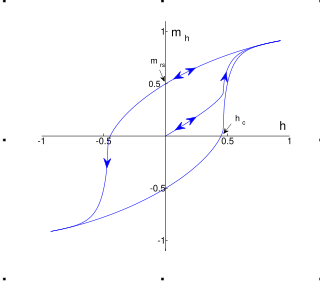 W
WMagnetic hysteresis occurs when an external magnetic field is applied to a ferromagnet such as iron and the atomic dipoles align themselves with it. Even when the field is removed, part of the alignment will be retained: the material has become magnetized. Once magnetized, the magnet will stay magnetized indefinitely. To demagnetize it requires heat or a magnetic field in the opposite direction. This is the effect that provides the element of memory in a hard disk drive.
 W
WMagnetic levitation (maglev) or magnetic suspension is a method by which an object is suspended with no support other than magnetic fields. Magnetic force is used to counteract the effects of the gravitational acceleration and any other accelerations.
 W
WThe magnetic moment is the magnetic strength and orientation of a magnet or other object that produces a magnetic field. Examples of objects that have magnetic moments include: loops of electric current, permanent magnets, moving elementary particles, various molecules, and many astronomical objects.
 W
WIn particle physics, a magnetic monopole is a hypothetical elementary particle that is an isolated magnet with only one magnetic pole. A magnetic monopole would have a net "magnetic charge". Modern interest in the concept stems from particle theories, notably the grand unified and superstring theories, which predict their existence.
 W
WA magnetic nano,, is a small metal container, measuring a centimetre in height and width, with a screw-top lid and a thin, cylindrical magnet at its base. They often have an O-ring seal between the lid and the body to make them easier to open and partially waterproof.
 W
WMagnetic refrigeration is a cooling technology based on the magnetocaloric effect. This technique can be used to attain extremely low temperatures, as well as the ranges used in common refrigerators.
 W
WMagnetic scalar potential, ψ, is a quantity in classical electromagnetism analogous to electric potential. It is used to specify the magnetic H-field in cases when there are no free currents, in a manner analogous to using the electric potential to determine the electric field in electrostatics. One important use of ψ is to determine the magnetic field due to permanent magnets when their magnetization is known. The potential is valid in any region with zero current density, thus if currents are confined to wires or surfaces, piecemeal solutions can be stitched together to provide a description of the magnetic field at all points in space.
 W
WIn physics, magnetic skyrmions are quasiparticles which have been predicted theoretically and observed experimentally in condensed matter systems. Skyrmions, named after British physicist Tony Hilton Royle Skyrme, can be formed in magnetic materials in their 'bulk' such as in MnSi, or in magnetic thin films. They can be achiral, or chiral in nature, and may exist both as dynamic excitations or stable or metastable states. Although the broad lines defining magnetic skyrmions have been established de facto, there exist a variety of interpretations with subtle differences.
 W
WMagnetic vector potential, A, is the vector quantity in classical electromagnetism defined so that its curl is equal to the magnetic field: . Together with the electric potential φ, the magnetic vector potential can be used to specify the electric field E as well. Therefore, many equations of electromagnetism can be written either in terms of the fields E and B, or equivalently in terms of the potentials φ and A. In more advanced theories such as quantum mechanics, most equations use potentials rather than fields.
 W
WMagnetoreception is a sense which allows an organism to detect a magnetic field to perceive direction, altitude or location. This sensory modality is used by a range of animals for orientation and navigation, and as a method for animals to develop regional maps. In navigation, magnetoreception deals with the detection of the Earth's magnetic field.
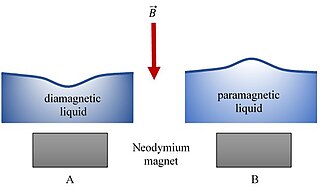 W
WIn physics, Moses effect is a phenomenon of deformation of the surface of a diamagnetic liquid by a magnetic field. The effect was named after Biblical figure Moses, inspired by the crossing of the Red Sea in the Old Testament.
 W
WCertain systems can achieve negative thermodynamic temperature; that is, their temperature can be expressed as a negative quantity on the Kelvin or Rankine scales. This should be distinguished from temperatures expressed as negative numbers on non-thermodynamic Celsius or Fahrenheit scales, which are nevertheless higher than absolute zero.
 W
WParamagnetism is a form of magnetism whereby some materials are weakly attracted by an externally applied magnetic field, and form internal, induced magnetic fields in the direction of the applied magnetic field. In contrast with this behavior, diamagnetic materials are repelled by magnetic fields and form induced magnetic fields in the direction opposite to that of the applied magnetic field. Paramagnetic materials include most chemical elements and some compounds; they have a relative magnetic permeability slightly greater than 1 and hence are attracted to magnetic fields. The magnetic moment induced by the applied field is linear in the field strength and rather weak. It typically requires a sensitive analytical balance to detect the effect and modern measurements on paramagnetic materials are often conducted with a SQUID magnetometer.
 W
WIn condensed matter physics, Quantum oscillations describes a series of related experimental techniques used to map the Fermi surface of a metal in the presence of a strong magnetic field. These techniques are based on the principle of Landau quantization of Fermions moving in a magnetic field. For a gas of free fermions in a strong magnetic field, the energy levels are quantized into bands, called the Landau levels, whose separation is inversely proportional to the strength of the magnetic field. In a quantum oscillation experiment, the external magnetic field is varied, which causes the Landau levels to pass over the Fermi surface, which in turn results in oscillations of the electronic density of states at the Fermi level; this produces oscillations in the many material properties which depend on this, including resistance, Hall resistance, and magnetic susceptibility. Observation of quantum oscillations in a material is considered a signature of Fermi liquid behaviour.
 W
WSeen in some magnetic materials, saturation is the state reached when an increase in applied external magnetic field H cannot increase the magnetization of the material further, so the total magnetic flux density B more or less levels off. Saturation is a characteristic of ferromagnetic and ferrimagnetic materials, such as iron, nickel, cobalt and their alloys. Different ferromagnetic materials have different saturation levels.
 W
WSoken tester - is a portable single yoke instrument for assessing the power loss in electrical steel laminations.
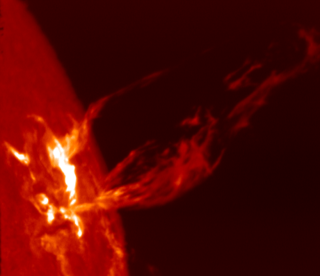 W
WA stellar magnetic field is a magnetic field generated by the motion of conductive plasma inside a star. This motion is created through convection, which is a form of energy transport involving the physical movement of material. A localized magnetic field exerts a force on the plasma, effectively increasing the pressure without a comparable gain in density. As a result, the magnetized region rises relative to the remainder of the plasma, until it reaches the star's photosphere. This creates starspots on the surface, and the related phenomenon of coronal loops.
 W
WStoletov curve shows the dependence of the magnetic permeability of ferromagnetics on the intensity of the applied magnetic field H. The curve is named after physicist Aleksandr Stoletov who analyzed in a long series of experiments the magnetic properties of iron rings in the period 1871–1872 during his stay at the Physical Laboratory of the University of Heidelberg.
 W
WIn magnetism the Stoner–Wohlfarth astroid curve is a curve that separates regions with two minima of the free energy density from those with only one energy minimum. It is a geometric representation of the Stoner–Wohlfarth model. This curve is of particular importance as discontinuous changes of the magnetization can take place when crossing it.